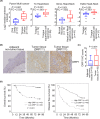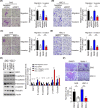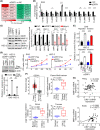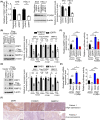DRP1 contributes to head and neck cancer progression and induces glycolysis through modulated FOXM1/MMP12 axis
- PMID: 35313071
- PMCID: PMC9251862
- DOI: 10.1002/1878-0261.13212
DRP1 contributes to head and neck cancer progression and induces glycolysis through modulated FOXM1/MMP12 axis
Abstract
Abnormal DRP1 expression has been identified in a variety of human cancers. However, the prognostic potential and mechanistic role of DRP1 in head and neck cancer (HNC) are currently poorly understood. Here, we demonstrated a significant upregulation of DRP1 in HNC tissues, and that DRP1 expression correlates with poor survival of HNC patients. Diminished DRP1 expression suppressed tumor growth and metastasis in both in vitro and in vivo models. DRP1 expression was positively correlated with FOXM1 and MMP12 expression in HNC patient samples, suggesting pathological relevance in the context of HNC development. Moreover, DRP1 depletion affected aerobic glycolysis through the downregulation of glycolytic genes, and overexpression of MMP12 in DRP1-depleted cells could help restore glucose consumption and lactate production. Using ChIP-qPCR, we showed that DRP1 modulates FOXM1 expression, which can enhance MMP12 transcription by binding to its promoter. We also showed that miR-575 could target 3'UTR of DRP1 mRNA and suppress DRP1 expression. Collectively, our study provides mechanistic insights into the role of DRP1 in HNC and highlights the potential of targeting the miR-575/DRP1/FOXM1/MMP12 axis as a novel therapy for the prevention of HNC progression.
Keywords: DRP1; FOXM1; MMP12; glycolysis; head and neck cancer; miR-575.
© 2022 The Authors. Molecular Oncology published by John Wiley & Sons Ltd on behalf of Federation of European Biochemical Societies.
Conflict of interest statement
The authors declare no conflicts of interest.
Figures








Similar articles
-
Propofol disrupts cell carcinogenesis and aerobic glycolysis by regulating circTADA2A/miR-455-3p/FOXM1 axis in lung cancer.Cell Cycle. 2020 Oct;19(19):2538-2552. doi: 10.1080/15384101.2020.1810393. Epub 2020 Aug 28. Cell Cycle. 2020. PMID: 32857667 Free PMC article.
-
Circ-FOXM1 contributes to cell proliferation, invasion, and glycolysis and represses apoptosis in melanoma by regulating miR-143-3p/FLOT2 axis.World J Surg Oncol. 2020 Mar 17;18(1):56. doi: 10.1186/s12957-020-01832-9. World J Surg Oncol. 2020. PMID: 32183822 Free PMC article.
-
Hsa_circ_0023990 Promotes Tumor Growth and Glycolysis in Dedifferentiated TC via Targeting miR-485-5p/FOXM1 Axis.Endocrinology. 2021 Dec 1;162(12):bqab172. doi: 10.1210/endocr/bqab172. Endocrinology. 2021. PMID: 34414414
-
The novel circCLK3/miR-320a/FoxM1 axis promotes cervical cancer progression.Cell Death Dis. 2019 Dec 12;10(12):950. doi: 10.1038/s41419-019-2183-z. Cell Death Dis. 2019. PMID: 31831728 Free PMC article.
-
Matricellular proteins: Potential biomarkers in head and neck cancer.J Cell Commun Signal. 2024 Apr 9;18(2):e12027. doi: 10.1002/ccs3.12027. eCollection 2024 Jun. J Cell Commun Signal. 2024. PMID: 38946720 Free PMC article. Review.
Cited by
-
Lactate metabolism-related genes serve as potential biomarkers for predicting gastric cancer progression and immunotherapy.Discov Oncol. 2025 Jun 5;16(1):1012. doi: 10.1007/s12672-025-02782-y. Discov Oncol. 2025. PMID: 40473996 Free PMC article.
-
An integrated analysis of dysregulated SCD1 in human cancers and functional verification of miR-181a-5p/SCD1 axis in esophageal squamous cell carcinoma.Comput Struct Biotechnol J. 2023 Aug 16;21:4030-4043. doi: 10.1016/j.csbj.2023.08.009. eCollection 2023. Comput Struct Biotechnol J. 2023. PMID: 37664175 Free PMC article.
-
YTHDC1-dependent m6A modification modulated FOXM1 promotes glycolysis and tumor progression through CENPA in triple-negative breast cancer.Cancer Sci. 2024 Jun;115(6):1881-1895. doi: 10.1111/cas.16137. Epub 2024 Apr 3. Cancer Sci. 2024. PMID: 38566554 Free PMC article.
-
SPIN1 accelerates tumorigenesis and confers radioresistance in non-small cell lung cancer by orchestrating the FOXO3a/FOXM1 axis.Cell Death Dis. 2024 Nov 15;15(11):832. doi: 10.1038/s41419-024-07225-0. Cell Death Dis. 2024. PMID: 39548064 Free PMC article.
-
Targeting of mitochondrial fission through natural flavanones elicits anti-myeloma activity.J Transl Med. 2024 Feb 27;22(1):208. doi: 10.1186/s12967-024-05013-0. J Transl Med. 2024. PMID: 38413989 Free PMC article.
References
-
- Bray F, Ferlay J, Soerjomataram I, Siegel RL, Torre LA, Jemal A. Global cancer statistics 2018: GLOBOCAN estimates of incidence and mortality worldwide for 36 cancers in 185 countries. CA Cancer J Clin. 2018;68:394–424. - PubMed
-
- Chow LQM. Head and neck cancer. N Engl J Med. 2020;382:60–72. - PubMed
-
- Siegel RL, Miller KD, Jemal A. Cancer statistics, 2018. Cancer J Clin. 2018;68:7–30. - PubMed
-
- Cancer Registry Annual Report, 2017. Taiwan.
Publication types
MeSH terms
Substances
LinkOut - more resources
Full Text Sources
Medical
Miscellaneous

